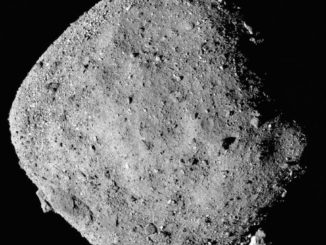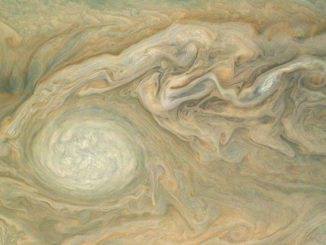
Data collected by NASA’s MAVEN spacecraft in its first two years at Mars confirm suspicions that the solar wind is blasting away the planet’s atmosphere and helped transform the world from a warmer, wetter and potentially habitable world into the barren landscape seen today, scientists said.
The robotic orbiter has been looping around Mars since September 2014, skimming just above the Martian atmosphere at the low point of its elongated orbit and searching for particles streaming away from the planet.
As Mars is bombarded by the solar wind, a stream of solar particles that flow out through the solar system at a million miles per hour, the red planet’s atmosphere is buffeted and eroded, chipping away bit by bit, according to Bruce Jakosky, MAVEN’s principal investigator at the University of Colorado, Boulder.
Researchers examining data from MAVEN’s instruments have identified multiple processes by which Mars loses parts of its atmosphere.
In one scenario called photochemical loss, solar radiation can ionize oxygen, carbon dioxide and nitrogen molecules in the Martian upper atmosphere. The reactions can split the molecules, scientists said, sometimes giving the resulting atoms enough energy to permanently escape Martian gravity.
“We have enough measurements that we can calculate the loss rate orbit-by-orbit,” Jakosky said March 20 at the Lunar and Planetary Science Conference near Houston.
Robert Lillis, a research physicist at the Space Sciences Laboratory at the University of California, Berkeley, said that MAVEN data show the photochemical loss rate has declined as solar radiation waned since the spacecraft arrived at Mars. The sun goes through an 11-year cycle of intense and quiet activity, and the cycle’s effects are observable Mars’s distance.
“MAVEN is making, in situ, most of the measurements necessary to calculate rates of photochemical escape,” Lillis said March 20.
The measurements collected by MAVEN so far are “consistent” an amount of oxygen loss from Mars over the last 3.5 billion years equivalent to about one-fifth of Earth’s present-day atmospheric pressure through the photochemical process alone, according to Lillis.
But there are other ways for atmospheric gases to escape from the tug of Mars and thin its atmosphere, and the photochemical process is just part of the picture.
“The next steps include cross-sections in modeling other species, and combining it with other escape processes to put this whole story together because it’s not just one escape process in isolation,” Lillis said. “They do feed into each other, so that’s the next step that the MAVEN team is embarking on. It’s a very complicated system, and this will take us a few more years.”
Scientists will also couple MAVEN’s atmospheric observations with the solar wind conditions at Mars to link the two data points and begin constructing a timeline of how molecules could have been stripped away from planet over the last 4 billion years.
Each time MAVEN dips into the upper atmosphere, the spacecraft’s science instruments scoop up the flow of particles in its path, giving researchers an idea of the velocity and direction the material is moving.
One of MAVEN’s instruments, the Solar Wind Ion Analyzer, spotted a halo of hydrogen around Mars that Jakosky said apparently fluctuates with the dustiness of the Martian atmosphere.
“What we think we’re seeing here is an increase that corresponds to the dusty season,” Jakosky said. “The dust changes temperatures in the atmosphere. That allows water to go up to high altitudes … So we think we’re putting water closer, or farther, from the vicinity of the corona.”
Jakosky said the escape rate of hydrogen, an indicator of water, can vary by a factor of 10 with the Martian seasons.
Particles need to be accelerated to a speed of around 8,500 mph (3.8 kilometers per second) at the outer edge of the atmosphere to permanently escape Martian gravity, according to Jakosky.
“Oxygen ions can be grabbed by the solar wind and stripped off,” Jakosky said. “That’s the primary mechanism.”
The oxygen streams away off the poles and down a tail down the side of Mars facing away from the sun.
According to Jakosky, the MAVEN science team believes oxygen ions 3.5 to 4 billion years ago were escaping the Martian atmosphere at a rate several orders of magnitude faster than today.
“The driver is the extreme ultraviolet (EUV) photons coming from the sun,” Jakosky said. “Although the sun itself — the total energy — has been getting brighter through time, the EUV radiation is getting dimmer through time.”
When solar radiation reaches Mars, it ionizes atoms and molecules in the atmosphere. Scientists say the ionization process is critical to propel particles away from the planet, which is not shielded from the solar wind by a magnetic field like Earth.
Astronomical observations of other sun-like stars tell scientists how the sun likely behaved billions of years ago.
At the rate of hydrogen escape today, Jakosky said Mars could have lost from 11.5 feet to 78 feet (3.5 meters to 24 meters) of water from its surface over the last 4 billion years.
But there’s an important caveat.
Scientists have not calculated how much more hydrogen left the ancient Martian atmosphere than leaves it today. A more active sun would have driven off more hydrogen, but experts have not ruled out a slower escape rate, especially if the atmosphere was more Earth-like.
“It’s very hard to know which way it goes, and I’m just going to leave it at a constant rate,” Jakosky said.
The MAVEN team is also examining how much carbon dioxide has disappeared from Mars.
“At the oxygen loss rate we measure, it would take about 2 to 4 billion years to remove all the oxygen in the atmospheric carbon dioxide, just multiplying the rate times 4 billion years,” Jakosky said.
Using Earth as a metric, that would be equivalent to an amount of carbon dioxide around 40 percent the pressure of Earth’s atmosphere at sea level.

Scientists have also identified “sputtering” events, in which blasts of radiation knock oxygen out of the atmosphere. This process is “negligible” today,” Jakosky said, but could have been much more prominent in the past, responsible for removing another chunk of carbon dioxide.
Individual solar storms also cause temporary spikes in atmospheric escape. One eruption in March 2015 triggered a 20-fold increase in the atmospheric loss rate, and the activity relaxed once the solar system was over, Jakosky said.
Solar storms were likely stronger and more common in the ancient solar system, and scientists question whether such events were responsible for much of the Martian atmosphere’s thinning over time.
Scientists have a way of calculating how much of the ancient Martian atmosphere has been ripped away. By measuring two isotopes of argon — one slightly heavier than the other — MAVEN can tell researchers what fraction of the atmospheric gas has been lost to space.
That allows scientists to complete the puzzle and determine whether the escaping oxygen came from carbon dioxide, which makes up about 95 percent of Mars’s present-day atmosphere, or from water, which is primarily locked in polar ice caps.
The lighter type of argon is more prone to escaping, while Martian gravity keeps a firmer hold on the heavier argon isotope.
“Relatively speaking, the larger isotope is more abundant because it doesn’t escape as much,” Jakosky said.
“Essentially, two-thirds of the argon that was ever in the atmosphere has been lost to space,” Jakosky said. “That really tells us that the loss of oxygen is coming from both water and carbon dioxide.”
That tells Jakosky and his team that most of Mars’s air and water has leaked away into space.
“The bottom line is that loss to space was certainly a major player, if not the major process, for changing Mars from having an early warm, wet climate in ancient times to the cold, dry climate we see today,” he said.
MAVEN is in an extended mission after completing its primary science campaign last year, and scientists hope more data will yield insights into how the atmosphere behaves year-to-year.
The prime mission phase covered one Martian year, and the extended mission’s funding is approved by NASA through 2018.
But the spacecraft has enough fuel to operate for up to another decade, Jakosky said, and MAVEN may eventually be used more often as a data relay satellite for landers and rovers on the Martian surface.
Officials are searching for the right balance between MAVEN’s scientific mission and its secondary function as a communications orbiter. NASA’s other Mars orbiters are aging — they have been at the red planet since 2001 and 2006 — but the European Space Agency’s ExoMars Trace Gas Orbiter, which arrived in October 2016, could take on much of the relay responsibilities.
“The long-term role of MAVEN as a relay asset is currently under discussion,” Jakosky said. “We are carrying out regular relay passes with the (the Opportunity and Curiosity) rovers, and we’ll see what happens as we get into interactions with InSight after it lands (in November 2018), especially in its commissioning phase, as well as with the Mars 2020 rover.”
Email the author.
Follow Stephen Clark on Twitter: @StephenClark1.



